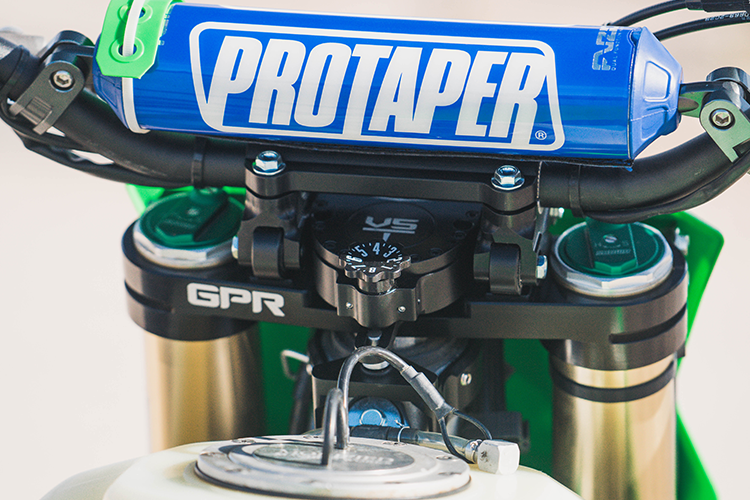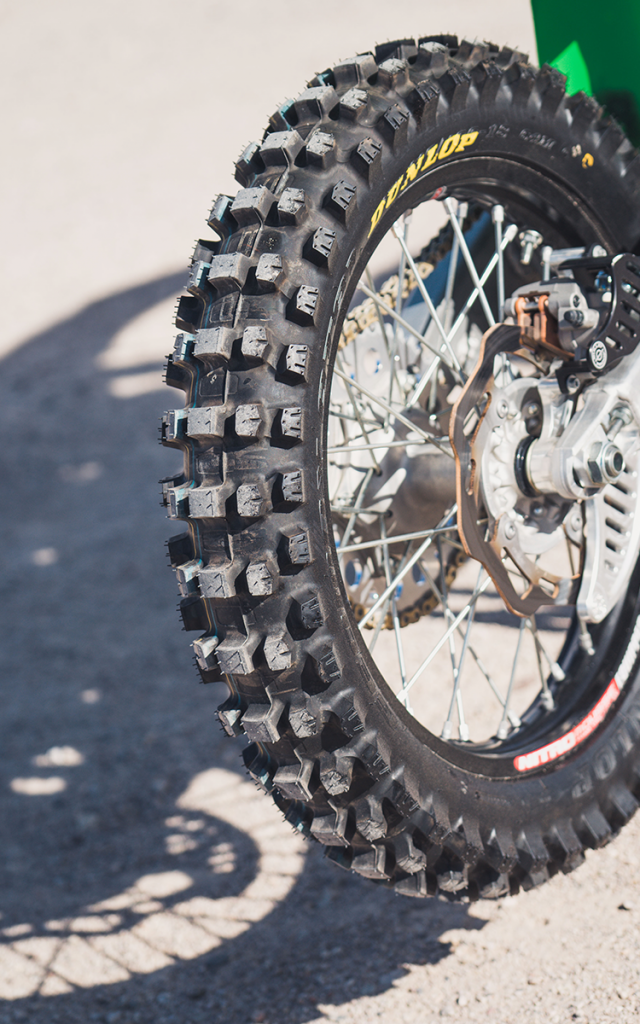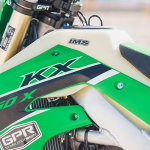Desert Spec KX450X
Story by Trevor Hunter, Photos by Trevor Hunter, Harlen Foley
 Remember the days of Team Green glory in the desert? The likes of Danny Hamel, Larry Roseler, Ty Davis, Destry Abbott, and many more all took their KX500’s to countless Hare & Hound, BITD, and District 37 victories with a sea of green hot on their tail. We remember it like it was yesterday and, as a result, we wanted to see if the KX450X is a capable desert sled that could get Kawasaki back to those glory days if in the right hands.
Remember the days of Team Green glory in the desert? The likes of Danny Hamel, Larry Roseler, Ty Davis, Destry Abbott, and many more all took their KX500’s to countless Hare & Hound, BITD, and District 37 victories with a sea of green hot on their tail. We remember it like it was yesterday and, as a result, we wanted to see if the KX450X is a capable desert sled that could get Kawasaki back to those glory days if in the right hands.
We’ve been on a green kick as of late trying to figure out the KX450X and where its limits are as an off-road race bike. We’re fans of this bike on the motocross track, and have grown to like it in a GP setting as well, but how well does this bike work in the desert? The KX450X is the closest bike to its MX counterpart in the XC race category on paper, which can mean it’s limited in its capabilities. To us, that serves as a chance to bring it out of its element and see how versatile of a bike we can make it. So, we brought the 2023 Kawasaki to Tonopah, NV for a 120 mile Hare and Hound for the last round of the Best In The Desert Championship.
Since the KX relies on a close-ratio five-speed transmission, gearing is pretty critical to accommodate everything a desert race throws your way. It’s tough to have a low enough first gear for tight singletrack and rocks while still having enough on the top end for fast roads and valleys. Stock on the X model is 13/51, but we dropped to 13/47 for a traditional “hare and hound” course. Why not go with a 14T up front? There’s very little space between the slave cylinder and the countershaft sprocket and the chain isn’t a clear fit with a larger front sprocket.

With the 13/47 gearing, we felt it was about perfect for 90% of the race. The gaps between gears were still close enough that it’d easily pull each gear without a drop in power. First and second gear were still low enough to chug through tight singletrack and rocky waterfalls with a finger on the clutch, and for most typical desert race situations, the top end speed is enough. We were put on some fast fire roads and dry lake beds where we ran out of gear around 87 mph. That top speed put a lot of stress on the motor so we stuck to ~80 mph to be easy on it where the bike wasn’t completely revved out.
We took this bike straight from the Blythe GP, a gnarly rough sand track, to Tonopah without changing any settings and the bike worked really well. We probably could have softened up compression on the fork a couple clicks to deflect less in the tight rocks, but overall this was one of the best handling bikes we’ve ridden in the desert. The chassis and suspension soaked up everything well with little deflection, kicking, or anything in that nature. We were very impressed with how well this bike handled throughout the 120 miles from long valleys, singletrack through the trees, rocky canyons, and tight sand washes.

We finally got our hands on a GPR Steering Stabilizer for this bike and that was a huge help for when the speeds rose and the terrain roughened up. We had zero head shake all day which is something we had been struggling with previously. Running the Pro Kit with the rubber mounted bar mounts, it only raises the bars 5mm. Since the stock 839 Renthal Fatbars are on the taller side already, we put on a set of Pro Taper CR Mid bend handlebars. This tightens up the cockpit a little and being a shorter rider, it helped tremendously in tight terrain being able to control the bike easier.
With this gearing and a fairly fast course, we made it to Pit 1 at 53.5 miles with a 2.8 gal tank with no issues. In speaking with Argubright, he’s gone ~63 miles on a tank of gas in V2R style testing (fast, fast fire roads). We also ran the Green, or Standard, coupler for this race. The race site is at ~6,000ft elevation so the bikes feel a bit slower, thus we went with the slightly more aggressive mapping coupler over the “mellow” coupler that comes stock on the X model.
Tires of choice were Dunlop’s AT81 rear tire and a MX33F front tire stuffed with Nitromousses. The terrain around Tonopah is pretty soft in nature so the MX33F front worked really well while the AT81 is a versatile tire that we had no issues with.
Some of the simple stuff like an Acerbis Skid Plate and Bullet Proof Designs Rear Disc Guard are little protection pieces that help protect the bike.




As we stated before, we were a bit skeptical of racing this bike in the desert simply because it is so motocross based with a MX transmission and very little changes from the moto bike. We weren’t as questionable about the bike’s handling, but all aspects of the bike really, really impressed us. The gearing was spot-on for everything except the abnormally long stretches of road and lake beds. The bike was nimble enough through the trees and rocky canyons but still plenty stable across choppy valleys and sand washes, taking us to 2nd Overall behind Husqvarna’s Dalton Shirey.
If we were to change anything, it’d be a six-speed transmission, or at least semi-wide ratio to accommodate higher speed terrain easier, and a cable clutch, but that’s more of a personal preference. Although, this hydro clutch feels like it has the “largest” engagement window and isn’t quite so on-off like other hydraulic clutches. Also, an exhaust or some mapping changes would be helpful to smoothen out the bottom end and initial hit just a tad so the bike is smoother and easier to ride in tight terrain. If we were to go race any National Hare and Hound or local desert race, this bike ranks up there as one of the first bikes we’d choose – something we didn’t expect prior to this weekend.
Do You Like DBT Bringing You Fresh Content? Search and Shop Through the Links Above or Below:





















